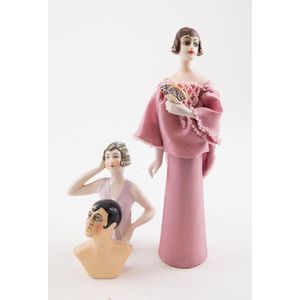Art Deco China Head Dolls with Bob & Crimped Hair
Wax over composition & two china half head dolls Art Deco head with moulded 'Bob' hair cut and two German Art Deco china head with crimped hair #12500 20 cm, 10 cm
You must be a subscriber, and be logged in to view price and dealer details.
Subscribe Now to view actual auction price for this item
When you subscribe, you have the option of setting the currency in which to display prices to $Au, $US, $NZ or Stg.
This item has been sold, and the description, image and price are for reference purposes only.
- Art Deco Period - The Art Deco period was a cultural movement that emerged in the 1920s and 1930s, and was characterized by its emphasis on modernism, luxury, and elegance. The name "Art Deco" comes from the Exposition Internationale des Arts Décoratifs et Industriels Modernes, a large exhibition held in Paris in 1925 that showcased the latest trends in decorative arts.
Art Deco was a reaction against the ornate and elaborate styles of the previous era, and reflected a new modern sensibility. It was characterized by streamlined, geometric shapes, bright colours, and the use of new materials such as chrome, glass, and Bakelite. Art Deco designers sought to create a sense of luxury and sophistication, often incorporating expensive materials such as ivory, marble, and rare woods.
Art Deco had a significant impact on a wide range of artistic fields, including architecture, fashion, graphic design, and interior design. Some of the most iconic examples of Art Deco architecture include the Empire State Building in New York City, the Hoover Building in London, and the Palais de Chaillot in Paris.
The Art Deco period came to an end in the 1940s, as World War II and changing cultural trends led to a shift in artistic styles. However, Art Deco remains an important influence on design and art, and continues to be celebrated for its modernist sensibility and glamorous aesthetic. - Composition - Composition is a material used for dolls, sculpture and furniture. It is a type of composite material made from a mixture of materials such as sawdust, glue, and pigments. It is a popular material for dolls and figurines because it is lightweight and easy to work with. It is also used in furniture-making, particularly in the construction of decorative pieces such as figurines and sculptures. It is less common in high-end furniture as it is not as durable as some other materials such as wood or metal. However, it is a more affordable and accessible option for some types of decorative pieces.
- China Head Dolls - Vintage china head dolls were typically made using a process called "slip casting." This process involved pouring a liquid mixture of porcelain, called "slip," into a mold. Once the porcelain had hardened enough to hold its shape, the mold was opened, and the newly formed porcelain head, hands, and feet were removed. The porcelain pieces were then fired in a kiln to harden them further and remove any remaining moisture. After firing, the dolls' features such as eyes, nose, ears, mouth, and hair were painted on by hand, and the dolls were assembled with a cloth or composition body, and sometimes dressed in period clothing, and had human hair wigs. The dolls were then fired a second time to set the paint and glaze.
This item has been included into following indexes:
- dolls
- German, unmarked - dolls 240
Visually similar items

Japanese carved netsuke, carved in the form of a standing figure holding a branch and fruit, stained, signed height 8.6 cm
Sold by
in
for
You can display prices in $Au, $US, $NZ or Stg.

A pair of Bow frilled pot pourri vases and covers, circa 1765. 23 cm high (2)
Sold by
in
for
You can display prices in $Au, $US, $NZ or Stg.

A Moorcroft McIntyre large 'Pansy' double-handled vase, back stamp and signature to base, c.1911. Height 20 cm
Sold by
in
for
You can display prices in $Au, $US, $NZ or Stg.

Royal Doulton figure Denise HN2273
Sold by
in
for
You can display prices in $Au, $US, $NZ or Stg.
